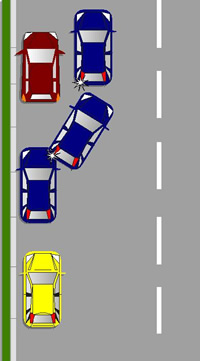Driving instructor vacancies in Basildon
- Jul 08, 2019
T his makes use of the vehicle's manoeuvrability in reverse gear to park in a restricted space.
Reverse Parking was only introduced into the driving test curriculum about 20 years ago, so many motorists would not have been taught how to do the manoeuvre.
Indeed, some driving instructors may be in doubt if they haven't fully understood through their training. This manifests itself, when instructors complicate and focus on the less important criteria of the manoeuvre.
A variety of techniques are delivered to unsuspecting learners from the 1 to 1 steering technique to looking in the wrong direction for certain markers.
Follow these simple steps to park safely and reasonably close to a kerb each time.
Overview
It makes sense to practise using only one parked car being conscious of having a limited to gap to reverse into, generally about 2 car lengths.
When you've mastered the technique, you should be able to park in between two vehicles, ideally leaving, half a car length in front and behind. This will allow for room when exiting the space safely.
Remember, while you're carrying out this manoeuvre, you could be a hazard to other road users.
Position and Observation
Good all round observation is essential throughout this exercise.
Avoid starting the manoeuvre if you're likely to inconvenience or endanger other road users.
Other drivers might not be aware of your intentions, so before you pull up at the place you've chosen to park, make sure you carry out the MSM routine.
Positioning your vehicle
Stop your vehicle reasonably close and parallel to the target vehicle, ahead of the gap. It makes sense to leave approximately, one open door length as to avoid touching vehicles. This will vary according to available road space. 
Your vehicle should be slightly ahead of the parked vehicle but not too far as this might cause confusion.
Manoeuvring into the space
Apply the parking brake, if necessary. Consider showing the brake lights and select reverse gear to alert others to your intentions.
Check all round, starting over your right shoulder, including mirrors and ahead. Finish by looking over your left shoulder through the rear windscreen as this is the direction you wish to travel.
At this point, it would make sense to turn in the seat to avoid placing strain on your neck and maximise your ability to see effectively.
Coordinate the pedals (brake or accelerator) depending on road gradient, bring the clutch up to the biting point and if still safe, release the parking brake if you applied it.
Hold the clutch pedal steady at the bite point using clutch control to manoeuvre at slow speed. Reverse slowly until the rear of the vehicles are level. Turning any earlier may mean you turn into the vehicle, turning later will reduce the available space.
At the turn point, remember to look all around again, for pedestrians, oncoming traffic and other road users, particularly as the front of your vehicle will swing out as you turn.
Reverse slowly using left lock until the rear offside (right hand side) rear roof pillar hides the kerb or nearside headlight of the vehicle behind the space you're entering.
This may be varied according to your initial starting point, i.e. how wide or close from the kerb you started. For example, if the target vehicle is a van (wide vehicle) that has parked a greater distance from the kerb, you will need to turn in for a longer period. Alternatively, if the vehicle is close or narrow, less turning will be necessary.
The exact amount of steering can be adequately assessed based on what you see through the rear window.
Straightening up in the gap
Straighten up by taking off the left lock. It makes sense to check the front of your vehicle at this point as there's a danger of clipping the vehicles. However, it should be noted that if your turn point was correct this is unlikely.
When you are sure the front of the vehicle is clear of the parked car use sufficient right lock to gradually bring your vehicle parallel with, and reasonably close to the nearside (left) kerb. Straighten the wheels by taking the right lock off and adjust the position as necessary, again based on what you see.
Very simply, the steering direction is left towards the kerb, right to straighten the car and then left to straighten the wheels.
The size of the gap will determine how quickly you steer but usually, turn slowly until you straighten the wheels. This should be quicker as you do not want to lose the near straight position of the car.
A general guide is to match the speed of car travel to the speed of the steering.
Conclusion
If still in doubt, consider the speed and amount of steering you do when manoeuvring away from the kerb and around a parked obstruction.
At all times, observe effectively in the direction of travel (behind) and around, acting upon what is seen accordingly.